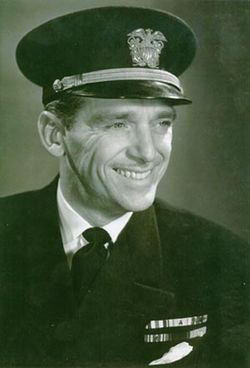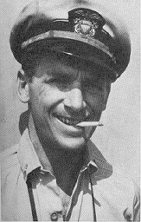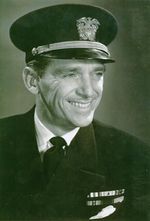Douglas Fairbanks, Jr
| Douglas Fairbanks, Jr. | ||
 | ||
| Background information | ||
| Born as: | Douglas Elton Ulman Fairbanks | |
| Born | Dec 9, 1909 New York City, New York | |
| Died | May 7, 2000 - age 91 New York City, New York Heart attack | |
| Spouse(s): | Joan Crawford (1929-1933) Mary Lee Eppling (1939-1988) Vera Shelton (1991-2000) | |
Click here for Early Movie History category page |
Click here for Movie Star category page |
Click here for World War II History category page |
Douglas Elton Fairbanks, Jr., KBE (Order of the British Empire), DSC (Distinguished Service Cross), OStJ (Sovereign Military Order of Malta) (✦December 9, 1909 - †May 7, 2000) was an American actor and a highly decorated United States naval officer of World War II.
Birth
Douglas Fairbanks, Jr. was born in New York City, the son of actor Douglas Fairbanks, Sr., and his first wife, Anna Beth Sully. His parents divorced when he was ten years old. He lived with his mother in California, Paris, and London.
Hollywood
Largely on the basis of his name, he was given a contract at age fourteen with Paramount Pictures. After making some undistinguished films, he took to the stage, where he impressed his father, his step-mother Mary Pickford, and Charlie Chaplin, who encouraged him to continue with acting.
He began his career during the silent era. He was exceptionally handsome and initially played mainly supporting roles in a range of films featuring many of the leading female players of the day, Belle Bennett in Stella Dallas (1925), Esther Ralston in An American Venus (1926) and Pauline Starke in Women Love Diamonds (1927). In the last years of the silent period he was upped to star billing opposite Loretta Young in several pre-Code films, and Joan Crawford in Our Modern Maidens (1929). He supported John Gilbert and Greta Garbo in Woman of Affairs (1929). Progressing to sound, he played opposite Katharine Hepburn in her Oscar-winning role in the film Morning Glory (1933).
With Outward Bound (1930), The Dawn Patrol (1930), Little Caesar (1931), and Gunga Din (1939), his movies began to have more commercial success.
Marriages
His first notable relationship was with the actress Joan Crawford, whom he began to seriously date during the filming of their film Our Modern Maidens. On June 3, 1929, at City Hall in New York City, Crawford and Fairbanks married. He was technically underage, so one year was added to his birth (giving him 1908 as his year of birth), and Crawford shed three years from her age, which would remain shed until long after her death, giving her the same year of birth that Fairbanks had created for himself, 1908.
They went on a delayed honeymoon to England, where he was entertained by Noel Coward and George, Duke of Kent. He became active in both society and politics, but Crawford was far more interested in her career and her new affair with Clark Gable. The couple divorced in 1933.
Despite their divorce, Fairbanks and Crawford maintained a good relationship. In his later years, Fairbanks was quick to defend Crawford when her adopted daughter Christina Crawford, published Mommie Dearest, a scathing biography of Crawford's personal life. He firmly stated, "The Joan Crawford that I've heard about in Mommie Dearest is not the Joan Crawford I knew back when."
On April 22, 1939, he married Mary Lee Hartford (né e Mary Lee Epling), a former wife of George Huntington Hartford, the Atlantic & Pacific Tea Company heir.
Douglas and Mary Lee had three daughters, Daphne, Victoria and Melissa. They were happily married for nearly fifty years, until Mary Lee died in 1988.
World War II
In 1941, President Franklin Delano Roosevelt appointed him a special envoy to South America.
Although celebrated as an actor, Fairbanks most enduring legacy was a well-kept secret for decades. At the onset of World War II, Fairbanks was commissioned a reserve officer in the U.S. Navy and assigned to Lord Mountbatten's Commando staff in England.
Having witnessed (and participated in) British training and cross-channel harassment operations emphasizing the military art of deception, Fairbanks attained a depth of understanding and appreciation of military deception then unheard of in the United States Navy. Lieutenant Fairbanks was subsequently transferred to Virginia Beach where he came under the command of Admiral H. Kent Hewitt, who was preparing U.S. Naval forces for the invasion of North Africa.
Fairbanks was able to convince Hewitt of the advantages of such a unit, and Admiral Hewitt soon took Fairbanks to Washington, D.C. to sell the idea to the Chief of Naval Operations, ADM Ernest King. Fairbanks succeeded and ADM King issued a secret letter on 5 March 1943 charging the Vice Chief of Naval Operations with the recruitment of 180 officers and 300 enlisted men for the Beach Jumper program.
The Beach Jumpers mission would simulate amphibious landings with a very limited force. Operating dozens of kilometers from the actual landing beaches and utilizing their deception equipment, the Beach Jumpers would lure the enemy into believing that theirs was the location of the amphibious beach landing, when in fact the actual amphibious landing would be conducted at another location. Even if the enemy was less than 100-percent convinced of the deception, the uncertainty created by the operations could conceivably delay enemy reinforcement of the actual landing area by several crucial hours.
U.S. Navy Beach Jumpers saw their initial action in Operation Husky, the invasion of Sicily. Throughout the remainder of the war, the Beach Jumpers conducted their hazardous, shallow-water operations throughout the Mediterranean.
For his planning the diversion-deception operations and his part in the amphibious assault on Southern France, Lieutenant Commander Fairbanks was awarded the U.S. Navy's Legion of Merit with bronze V (for valor), the Italian War Cross for Military Valor, the French Legion d'Honneur and the Croix de Guerre with Palm, and the British Distinguished Service Cross. Fairbanks was also awarded the Silver Star for valor displayed while serving on PT boats.
He was made an Honorary Order of the British Empire Knight Commander of the British Empire (KBE) in 1949.
It is not a stretch to say that Douglas Fairbanks, Jr. was the father of the United States Navy's Information Operations. As for the Beach Jumpers, they changed names several times in the decades following World War II, expanded their focus, and are currently known as the Navy Information Operations Command. Fairbanks stayed in the Naval Reserve after the war and ultimately retired as a captain in 1954.
Many of the Navy's most important information operations since World War II remain classified, but it is clear that the U.S. military retains its interest in this art of war.
See also Fairbanks and the Navy
Post-war years
Fairbanks, Jr. returned to Hollywood at the conclusion of World War II and enjoyed success as host of the Douglas Fairbanks, Jr. Theater in the early years of television.
Fairbanks was a confirmed Anglophile and spent a good deal of his time in Britain, where he was well known in the highest social circles. The College of Arms in London granted Fairbanks a coat of arms symbolising the U.S. and Britain united across the blue Atlantic Ocean by a silken knot of friendship.
He died of a heart attack in New York at the age of 90. He is interred in the Hollywood Forever Cemetery in Hollywood, California, in the same crypt as his father.
Legacy
Fairbanks has two stars on the Hollywood Walk of Fame, one for motion pictures at 6318 Hollywood Boulevard and one for television at 6665 Hollywood Boulevard.
Trivia
- It has been claimed that Douglas Fairbanks, Jr. was one of the naked men in the incriminating photos which were used as evidence in the divorce trial of Margaret Campbell, Duchess of Argyll in 1963.
- He was good friends with legendary English stage and screen actor Sir Laurence Olivier, and was one of the contributors to a documentary of Olivier's life The South Bank Show Laurence Olivier: A Life.
Filmography
- American Aristocracy (1916)
- The Three Musketeers 1921)
- Stephen Steps Out (1923)
- The Air Mail (1925)
- Wild Horse Mesa (1925)
- Stella Dallas (1925)
- The American Venus (1926)
- Padlocked (1926)
- Broken Hearts of Hollywood (1926)
- Man Bait (1927)
- Women Love Diamonds (1927)
- Is Zat So? (1927)
- A Texas Steer (1927)
- Dead Man's Curve (1928)
- Modern Mothers (1928)
- The Toilers (1928)
- The Power of the Press (1928)
- The Barker (1928)
- A Woman of Affairs (1928)
- Hollywood Snapshots #11 (1929) (short subject)
- The Forward Pass (1929)
- The Jazz Age (1929)
- Our Modern Maidens (1929)
- Little Caesar (1931)
- Catherine the Great (1934)
- The Amateur Gentleman (1936)
- The Prisoner of Zenda (1937)
- Joy of Living (1938)
- The Rage of Paris (1938)
- Having Wonderful Time (1938)
- Gunga Din (1939)
- Green Hell (1940)
- Angels Over Broadway (1940)
- Sinbad the Sailor (1947)
- The Exile (1947)
- Ghost Story (1981)
References
External links
A Personal Note from Robin
You are probably asking yourself, "Why is there an article Doug Fairbanks Jr on SM-201?"
You have, no doubt seen the US Army and the Marines storming ashore at Anzio in Italy and Normandy in France during WWII. At Normandy, they landed on Omaha, Gold, and Juno beaches as the first ashore. How did they know it was Omaha beach? There was a sign there saying "Omaha Beach". Those signs were put there by a team of intrepid men known as Amphibious Alpha, Amphibious Bravo, etc. My father was one of those sailors attached to Amphibious Roger, and his Commanding Officer was Doug Fairbanks Jr.
My father and Doug stayed in touch after the war and we visited both Pickfair and San Simeon on several occasions in the late '40s and early '50s.
See also [ Fairbanks and the Navy ]
Chat rooms • What links here • Copyright info • Contact information • Category:Root

